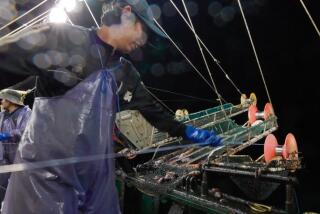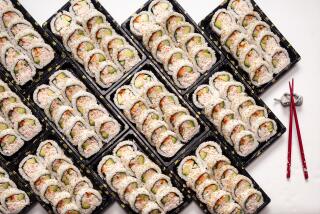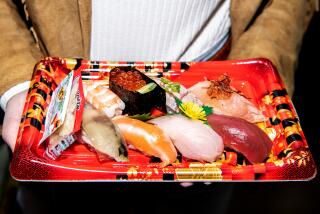Japan Has Yet to Be Grade-A Spot for Foreign Beef : Trade: The market is open, but the tariff on meat is high and many retailers aren’t passing on savings from imports.
TOKYO
Keizo Irie sees American beef in Japan’s future. Lots of it.
“When I was in high school, my favorite food was curry and rice,” says Irie, senior merchandiser of the meat division at Daiei, one of Japan’s largest supermarket chains. “Now if you ask high school students what food they like best, they’ll say, ‘Steak.’ ”
At the right price, says Irie, Japanese will more than double their consumption of beef.
That’s a radical notion in a country where many still believe that Japanese people have intestines too short to digest beef. Annual consumption here is just 12 pounds per person--less than a fifth what the average American eats.
A change in Japanese eating habits could be a boon for American beef producers, who face declining sales at home because of health-conscious consumers.
But a year after Japan dismantled its tough barriers to foreign beef, sales of imported beef aren’t taking off as expected. In fact, imports actually fell last year after a period of growth.
One reason was a large inventory of imported beef in warehouses from the year before. Another was continued high retail prices.
A sirloin steak, for example, costs $22 a pound at most supermarkets. Daiei, which used an aggressive pricing policy to boost import sales 50% last year, sells the same steak for about $15--a bargain for Japan but hardly cheap.
“There is a logjam in the system,” says Michael Johnson, East Asian representative for Mulford, the meat packing subsidiary of the Minneapolis-based commodities trader Cargill Inc. “If prices (would fall), demand could increase dramatically.”
The continuation of high beef prices in most shops long after formal import barriers have been removed says much about why Japanese consumer prices in general are so high.
The problems beef importers have encountered also demonstrate why even foreign companies with better, cheaper products continue to have a tough time breaking into the market.
The easy answer to why imported beef sales aren’t booming is high tariffs.
In exchange for agreeing to remove a quota system which kept imports at low levels, Japan imposed a 70% tariff on imported beef to protect domestic cattle growers, whose production costs are substantially higher than foreign producers--in part because the Japanese import feed grain.
As part of an agreement with the United States, Japan will reduce that tariff to 60% Wednesday and to 50% next year. Tariff rates will then be renegotiated.
But the high tariff does not explain all. Upon arrival, a one-pound imported sirloin steak costs the equivalent of just $3 to $4 a pound.
The tariff adds, at most, $3 to the price. So what accounts for the $22 retail price?
Importers say it’s a combination of a costly distribution system, retailer conservatism and consumer anxiety about the quality of imported products.
When retailers overcome their anxieties and buy cheaper, imported beef, they seldom pass on the savings to customers, therefore limiting demand.
A surge in low-cost beef from Australia led to a 20% drop in the wholesale prices of certain kinds of imported and domestic beef the first few weeks of this year. But retail prices didn’t budge.
“The smaller retailers and supermarket chains say their labor and administrative costs are up and they need cash to build larger stores,” says Toshi Tanaka, Japan director for the U.S. Meat Export Federation.
In some cases it is the distributor that seems to keep the savings. Yoshiaki Mano, who runs a small Tokyo butcher shop--one of 30,000 mom and pop shops nationwide--says his distributor never offered him cut-rate beef products. He doesn’t carry imported beef because “there is no demand for it. People aren’t used to it.”
Hirofumi Goto, an executive at Zenchiku, one of Japan’s largest importers and a distributor that sells to more than 10,000 stores, says there is little point to slashing prices.
“Just because you double the amount of meat you import and cut prices in half, it doesn’t mean the size of customers’ stomachs is going to double,” he says.
But Zenchiku, which is owned in part by Japanese beef producers, is also motivated to minimize damage to its shareholders. “We want a soft landing,” Goto said. “We don’t want anybody to bleed, to go bankrupt.”
Japanese consumers should have benefited from the liberalization of import quotas, says Ralph Hood, chief executive of the North Asia Region for the Australian Meat & Livestock Corp. “But that doesn’t seem to be occurring . . . Instead, the biggest beneficiary has been the retailer. This is no bonanza for the Australian or American industry.”
Hood says many retailers continue to stock only Japanese beef because of “the notion that imported products are inferior.”
Charges from consumer groups and domestic beef producers that foreign beef is tainted with pesticides and pumped with hormones and antibiotics has turned Japanese against imported food.
Since imported beef is strictly tested by Japanese authorities, a discovery of even minute amounts of antibiotics is played up in the local press.
Focus-group interviews show that consumers are deeply concerned about the safety of imported beef, Hood says.
Japanese beef is not subjected to the same tests as imported beef. And, curiously, Japanese consumers groups never express concern about the possibility that hormones, pesticides or antibiotics might be present in Japanese beef.
Since Japanese feed grain comes from America, it presumably contains no more or less pesticide residue than grain fed to cattle in the United States.
The Japanese notion that they have better inspection procedures than the United States or Australia is “laughable,” says Hood. “You know what they say about people in glass houses.”
To calm consumer fears, Daiei--which plans to double its purchases of American beef this year--and other retailers assure their consumers that their imported beef has been inspected in their own laboratories by Japanese personnel.
A Daiei advertisement for Kansas beef shows a big slab of beef frying on a grill in the center; in one corner, however, is a picture of men and women in lab coats doing experiments that presumably involve testing the meat.
Foreign beef producers are also promoting brand names in an effort to separate their products from the more generalized, negative “import” image. Washington State, for example, uses a “Washington Beef” label. Australia is promoting its “Aussie” brand beef on television.
Despite such efforts, according to some reports, the Japanese government is hurting imports with efforts designed to protect domestic producers. A Ministry of Agriculture official gathered importers in his office recently to suggest that perhaps supply was outpacing demand, a comment some importers took as “administrative guidance” suggesting that they cut imports.
Although most importers aren’t getting the sales growth they had hoped, American producers have more reason to smile than Australian.
Many had argued that market liberalization in Japan would help Australia more than America since it is the cheapest supplier of meat. But Japanese consumers have shown a preference for the more expensive, American grain-fed beef over the Australian range-fed product.
Last year, American producers took a 42% share of Japan’s imported beef market, up from 31.5% in 1986. Australia’s share fell to 52.2% last year from 60% six years ago.
Eventually, analysts say, both countries will end up winners. In spite of distribution and pricing problems and high tariffs, production costs in America and Australia are so much lower than in Japan that most observers agree that imports will eventually take over all but the 30% of the Japanese market dedicated to top-quality Kobe beef.
That beef, which sells for $150 a pound and up, is a category all its own. Analysts estimate that Japan will import 950,000 tons of beef by 1993, double the current level.
Irie of Daiei, for one, doesn’t plan to slow down his campaign to turn Japan into a nation of beef eaters. And he has confidence that he will succeed.
He boasts that his 17-year-old son, at about 5-foot-8, is four inches taller than he is “and can eat an 800-gram (1 3/4-pound) steak with no problem.”
Prices will have to come down a lot more before many Japanese start eating steaks of that size. At current prices, even at Daiei’s discounts, the meal would cost a hefty $25.
U.S. Beef Making Inroads in Japan
As Japanese beef imports have risen by more than 56% in the past five years, the United States’ share of the import market has also grown. Despite a decline in imports last year because of high retail prices, U.S. import share continued to gain ground.
Total Beef Imports Imports from U.S. Share (in tons) the U.S. of Imports 1987 223,606 84,611 37.8% 1988 285,415 128,678 41.6% 1989 358,997 151,665 41.7% 1990 384,199 164,393 42.8% 1991* 350,000 150,000 43.5%
*estimate
Source: Japan Ministry of Finance
More to Read
Inside the business of entertainment
The Wide Shot brings you news, analysis and insights on everything from streaming wars to production — and what it all means for the future.
You may occasionally receive promotional content from the Los Angeles Times.










